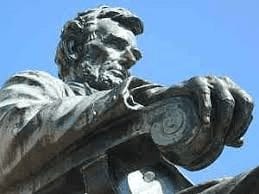Not Even Lincoln Is Spared the Wrath of the Statue Topplers – By Lindsay Marchello (reason.com) / Oct 16 2017
It began with Confederate monuments, but it was only a matter of time before the history of everyone ever commemorated in America was in dispute. Even Abraham Lincoln.
The statue of the 16th president and liberator of slaves at the top of Bascom Hill is one of the most beloved sites on the University of Wisconsin-Madison campus. Graduating students and their families wait in line for hours in the spring to have their pictures taken in Lincoln’s lap.
Wunk Sheek, an indigenous student group, does not share this sentiment. The group has charged that a statue of Lincoln has no place on campus.
“Everyone thinks of Lincoln as the great, you know, freer of slaves, but let’s be real: He owned slaves, and as natives, we want people to know that he ordered the execution of native men,” Misha Johnson, co-president of fiscal relations for Wunk Sheek told the Daily Cardinal, one of the student newspapers. “Just to have him here at the top of Bascom is just really belittling.”
It is wrong to say Lincoln ever owned slaves, but he was president during the Dakota War of 1862 and he did authorize the execution on December 26, 1862 of 38 Dakota men out of more than 300 convicted of war crimes in military tribunals.
According to College Fix, university administration has said it has no intention of moving Lincoln anywhere. But the school is planning on putting up a handful of signs around campus to “interpret the 12,000 year history” of those who inhabited the land upon which the university was built.
Madison’s Lincoln has been under siege for a while now. Two years ago, during the height of Black Lives Matter protests, a group, “About Race UW,” proposed removing the statue, but the idea never gained traction.
Since then the Lincoln statue has been subjected to graffiti decrying all white people as racist and draped in a black tarp after the 2016 election.
The UW student government this past Spring approved a resolution to educate the community about Lincoln’s oppression of Native Americans, a resolution the administration never took up.
Pressure to address racism and white supremacy after the terrible events at Charlottesville, where Neo-Nazis marched in the streets and one counter protester was killed, likely prompted UW Madison students and administrators to renew efforts to address the campus’ history, including the Lincoln statue.
Week Shunk insists the focus not be turned from Lincoln’s part in the Dakota War punishment. The history, like all history, is more complicated than it has been portrayed by the activists.
Between 400 and 800 U.S. citizens, 77 U.S. soldiers and more than 150 Dakota Native Americans died, although definitive numbers are hard to find.
“Anxious to not act with so much clemency as to encourage another outbreak on the one hand, nor with so much severity as to be real cruelty on the other, I caused a careful examination of the records of trials to be made,” Lincoln reportedly told the U.S. Senate after reviewing each trial of the over 300 Dakota men accused of war crimes.
The causes leading up to a terrible and bloody war, the treatment of Native Americans after the war, and the fairness of the military tribunals are all valid parts of a larger historical discussion.
Portraying Lincoln as a white supremacist who signed off on the execution of Native Americans distorts the discussion. Demanding the Lincoln statue be removed is demanding the discussion be silenced.
Answering the demands of activists without any certainty that the complexities and nuances of history will be included reflects a troubling trend. Whether Christopher Columbus, Thomas Jefferson, or Lincoln, people need to be exposed to and learn to navigate the complexity of their shared history.
Not enough history is required of students. Revising how history is taught in schools and universities is a possible solution to the complex question. Perhaps teachers could incorporate more first person accounts from a broader spectrum of voices to paint a more accurate picture of the past. Moving away from textbook learning could be the first step toward engaging students to not only think for themselves, but to grapple with the moral complexity of history’s key figures
http://reason.com/archives/2017/10/16/not-even-lincoln-is-spared-the-wrath-of
PB/TK – It’s coming to a point where I, a bald fat white guy, is afraid to sit “Indian style” while drinking a chocolate milk from a Styrofoam cup while hanging out with my hypoallergenic Chihuahua/St Bernard dog




















